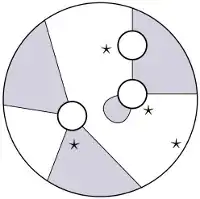In the planar algebra theory (see here or there section 2), a planar tangle is an isotopy class; then to define the composition of two tangles, we need to choose a representative in each classes. See below for a quick definition of planar tangles, composition and tangle isotopy.
Question: What's the detailed proof of "the composition of planar tangles is well-defined"?
(with all i's dotted and t's crossed)
Remark: A series of lectures given by Vijay Kodiyalam on the fundation of the planar algebra theory can be found in this link.
Quick definition of planar tangles and composition
A (shaded) planar tangle is the data of finitely many "input" disks, one "output" disk, non-intersecting (smooth) strings giving $2n$ intervals per disk and one $\star$-marked interval per disk. A tangle is defined up to isotopy.

To compose two planar tangles, put the outup disk of one into an input of the other, having as many intervals, same shading of marked intervals and such that the marked intervals coincide. Finally we remove the coinciding circles (possibly zero, one or several compositions).

Tangle isotopy
The definition of a tangle isotopy is implicitly the one so that the "data needed" (for subfactors theory) is kept.
I will try an explicit and concrete definition (I invite the experts to correct it).
Two tangles are isotopic if we can go from one to the other by the following smooth deformation:
- the radius and the center of an "input" disk can smoothly vary as long as the radius stays strictly positive and as long as the "input" disk does not touch an other "input" disk, an other string or the border of the "output" disk.
- the contact points of a disk (with strings) can vary smoothly as long as they don't cross (or touch) themselves.
- when an "inner" disk varies or when the contact points varies as above, an open strings touching the disk should vary smoothly so that the contact point follow the deformation, and the string does not touch itself, an other string, an other "input" disk or the border of the "output" disk.
- a string can also vary smoothly as long as it keeps its endpoints (for the open string case), and as long as the string does not touch itself, an other string an other "input" disk or the border of the "output" disk.
- the $\star$-marked intervals and the shading follow the deformation.
- (optional) we could also add the "spherical isotopy" for the tangles whose "output" disk has no contact point.